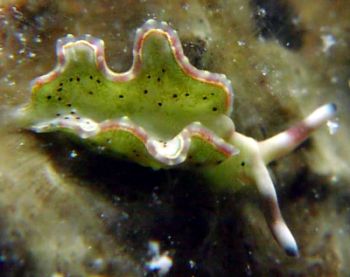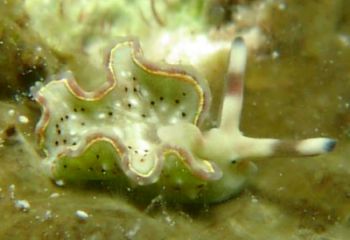Re: Elysia lobata from Japan
September 9, 2001
From: Jun Imamoto


Dear Bill.
I saw your message about Elysia lobata. As I had previously only sent one photo of this animal I tried to look for another one. While looking through my photos I found a slight difference in colour in different photos of the same individual.
In one photo you can see a pattern of white spots while in the other photo the white spots are not there although the photos are of the same animal.
I was surprised to find such a change of color in such a short time. I think that the observation of sea slugs is very pleasant.
Place: Zamami Kerama Ids, Japan, July 13, 2001. Depth: 10m; Size: about 10mm
Water temperature: 28C degrees.
Best Regards,
Jun Imamoto
imamoto@wips.co.jp
Imamoto, J. , 2001 (Sep 9) Re: Elysia lobata from Japan. [Message in] Sea Slug Forum. Australian Museum, Sydney. Available from http://www.seaslugforum.net/find/5234Dear Jun,
Thanks for these photos. The appearance of the white pustules is quite interesting. I have often suspected that in species of Elysia, such as Elysia ornata, the white pustules which are sometimes present in the parapodia, are either glands, or storage sacs for the white defensive secretions that sacoglossans often exude when disturbed. As I have discussed elswhere on the Forum, these secretions are almost certainly derived from defensive chemicals produced by the plants they feed on.
I thought at first that perhaps the lighting in the photos made the white spots visible in one photo but not the other but in the loswer photo they are clearly visible on both the lighted side of the parapodia and the shaded side. On the outside of the parapodia they appear as quite swollen pustules. My guess is that these are mantle glands, swollen with their white defensive secretions. In the upper photo the glands are empty and so no white region can be seen. If this is correct then the most likely situation is that when you first found the animals the glands were full, but for some reason they emptied the secretions before you took the second photo. Alternatively the opposite could be true. Perhaps the secretions are spread thinly throughout the body wall and only move to the 'glands' or 'sacs' when the animal is disturbed and preparing to discharge the secretions. If that is the case, then your white spotted photo shows an 'irritated' animal about to discharge its nasty secretions.
It would not be that difficult to test. If you find some of these animals, or Elysia ornata, which also sometimes has white spots, take a photo and then gently irritate the animal by touching or poking it with a stick and see what happens. If it has white spots when you start it might secrete a sticky white mucus and lose the spots. If it doesn't have spots when you start it might develop white spots as the secretions aggregate into pustules before being released. Either way it would be an interesting little experiment.
I am glad you are finding the study of these animals so interesting. I must say I am also finding your messages and photos extremely interesting.
Best wishes,
Bill Rudman
Related messages
-
Elysia lobata & E. tokarensis
From: Cynthia Trowbridge, January 29, 2007 -
Elysia lobata from Japan
From: Bill Rudman, September 4, 2001 -
Elysiidae from Kerama Ids, Japan (2)
From: Jun Imamoto, August 7, 2001
